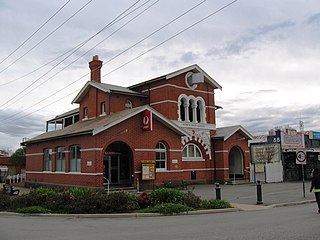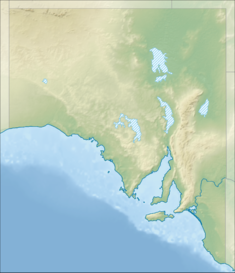
The Port Pirie Post Office is a heritage-listed post office at 79-83 Ellen Street, Port Pirie, South Australia. It was designed by Edward Woods and built in 1880, with extensions designed by Charles Owen-Smyth built in 1905–1907. It was added to the South Australian Heritage Register on 12 October 1995 and added to the Commonwealth Heritage List on 8 November 2011.

Temora Post Office is a heritage-listed post office at 173 Hoskins Street, Temora, New South Wales, Australia. It was added to the Australian Commonwealth Heritage List on 8 November 2011.

Camden Post Office is a heritage-listed post office at 135 Argyle Street, Camden, New South Wales, Australia. It was added to the Australian Commonwealth Heritage List on 22 August 2012.

Cronulla Post Office is a heritage-listed post office at 41 Cronulla Street, Cronulla, Sydney, New South Wales, Australia. It was designed by Edwin Hubert Henderson of the Commonwealth Department of Works and Railways and built in 1924. It was added to the Australian Commonwealth Heritage List on 22 August 2012.

Ayr Post Office is a heritage-listed post office at 155 Queen Street, Ayr, Shire of Burdekin, Queensland, Australia. It was designed by the Commonwealth Department of Interior and was built in 1936. It was added to the Australian Commonwealth Heritage List on 22 August 2012.

Bowen Post Office is a heritage-listed post office at 46 Herbert Street, Bowen, Queensland, Australia. It was designed by the Commonwealth Department of the Interior and constructed in 1936. It was added to the Australian Commonwealth Heritage List on 8 November 2011.

Stanthorpe Post Office is a heritage-listed post office at 14 Maryland Street, Stanthorpe, Southern Downs Region, Queensland, Australia. It was designed by John Smith Murdoch of the Queensland Government Architect's office and was built by D. Stewart and Co in 1901. It was added to the Australian Commonwealth Heritage List on 22 June 2004.

Cooroy Post Office is a heritage-listed post office at 33 Maple Street, Cooroy, Shire of Noosa, Queensland, Australia. It was designed by Thomas Pye and built in 1914 by L. Baldry. It was added to the Australian Commonwealth Heritage List on 22 August 2012.

Ingham Post Office is a heritage-listed post office at 15 Lannercost Street, Ingham, Shire of Hinchinbrook, Queensland, Australia. It was built in 1935. It was added to the Australian Commonwealth Heritage List on 22 August 2012.

Euroa Post Office is a heritage-listed post office at 90 Binney Street, Euroa, Victoria, Australia. It was designed by John Thomas Kelleher of the state Public Works Department, possibly with the assistance of A. J. McDonald, and built in 1890 by George Diggle. It was added to the Australian Commonwealth Heritage List on 22 August 2012.

Hamilton Post Office is a heritage-listed post office at 57 Gray Street, Hamilton, Victoria, Australia. It was designed by C. H. E. Blackman of the colonial Public Works Department under the aegis of William Wardell, built in 1876, and occupied in 1878. It was added to the Australian Commonwealth Heritage List on 8 November 2011.

Kerang Post Office is a heritage-listed post office at 51-53 Victoria Street, Kerang, Victoria, Australia. It was designed by the Victorian Colonial Architect, George William Watson, and was built in 1886. It was added to the Australian Commonwealth Heritage List on 8 November 2011.

Leongatha Post Office is a heritage-listed post office and former telegraph office at 4 McCartin Street, Leongatha, Victoria, Australia. It was designed by J. B. Cohen of the state Public Works Department for the Commonwealth Government. It was added to the Australian Commonwealth Heritage List on 22 June 2004.

Maryborough Post Office is a heritage-listed post office at 69 Clarendon Street, Maryborough, Victoria, Australia. It was designed by John Hudson Marsden and built in 1876-77, with the clock tower added in 1879. It was originally built as a combined court house, post and telegraph office and Colonial office, though the post office alone has occupied the building since 1892. It was added to the Australian Commonwealth Heritage List on 8 November 2011.

Castlemaine Post Office is a heritage-listed post office at 202 Barker Street, Castlemaine, Victoria, Australia. It was added to the Australian Commonwealth Heritage List on 8 November 2011.

Stawell Post Office is a heritage-listed post office at 87-89 Gold Reef Mall, Stawell, Victoria, Australia. It was designed by Alfred T. Snow of the colonial Department of Public Works and built by Thomas Walker in 1874–75. It was added to the Australian Commonwealth Heritage List on 22 June 2004.

Queenstown Post Office is a heritage-listed post office at 32-34 Orr Street, Queenstown, Tasmania, Australia. It was designed by the Tasmanian government's Public Works Office and built in 1902, with the tower added in 1909. It was added to the Australian Commonwealth Heritage List on 22 June 2004.

Northam Post Office is a heritage-listed post office at 239-243 Fitzgerald Street, Northam, Western Australia, Australia. It was added to the Australian Commonwealth Heritage List on 22 June 2004.

Victoria Park Post Office is a heritage-listed post office at 414 Albany Highway, Victoria Park, Western Australia, Australia. It was added to the Australian Commonwealth Heritage List on 22 August 2012.
Renmark Post Office is a heritage-listed post office at 24 Ral Ral Avenue, Renmark, South Australia, Australia. It was added to the Australian Commonwealth Heritage List on 8 November 2011.




















